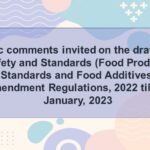The Department for Promotion of Industry and Internal Trade, Ministry of Commerce and Industry (“Ministry”), has proposed changes to the Indian Boiler Regulations, 1950 (“Principal Regulations”), through the Draft Indian Boiler (Second amendment) Regulations, 2020 (“Draft Regulations”).
Objections or suggestions with regard to the Draft Regulations have been allowed till 17th July, 2020.
The objections or suggestions may be addressed to the “Secretary, Central Boilers Board, Ministry of Commerce and Industry (Department for Promotion of Industry and Internal Trade), Room No. 358, Udyog Bhawan, New Delhi- 110 011”; or e-mailed at tsg.narayannen@nic.in.
Key Changes
| Original Position (Principal Regulations) | Proposed Change (Draft Regulations) |
| Regulation 4 (c) (vi):
For tubes and pipes subjected to internal pressure, a certificate giving results of tests regarding chemical analysis, warm yield point (0.2 per cent proof stress), the average stress to produce an elongation of 1 per cent (creep) in 100,000 hours and the average and the lowest stresses to produce rupture in 100,000 hours in the material wherever applicable, shall be furnished. NOTE:- Until 33,000 hours tests are carried out by National Metallurgical Laboratory or Corporate Research and Development Laboratory of Bharat Heavy Electricals Limited for collecting elevated temperature data of alloy steel produced indigenously against ASME or BS or EN Code, these grades of steel may be accepted and long time elevated temperature properties/maximum allowable stress values given in ASME or BS or EN Code, as the case may be, may be used for the purpose of design. Provided that (I) a certificate is furnished by the producer of the steel to the effect that the steel has been manufactured strictly in accordance with the technical requirements of the ASME or BS or EN Code to assure that the creep rupture requirements are complied with. (II) the Steel maker furnishes the necessary certificate that the steel conforms to the chemical analysis, room and elevated temperature mechanical properties given in ASME or BS or EN Code as the case may be. (III) the short-term stress-rupture tests for 1000 hours as described below are carried out by NML/Steel Plants for the purpose of checking whether the steel is up to the specification and also to ensure that the Steel is capable of meeting the long-term rupture stress values/ maximum allowable stress values given in ASME or BS or EN Code, as the case may be, and a certificate is given by NML/Steel plant to this effect. (IV) two numbers of 1000 hour creep rupture tests shall be carried out at a temperature 50 degree celsius above the service temperature for each grade of steel for tubing or piping or castings or plates grades; when in furnace and/or in superheater zone. However, the forging to be used in valves should be tested at 550 degree celsius for 1000 hours. The stress to cause rupture in 1000 hours at above temperatures may be taken from the master curve corresponding to 20% line. At this stress, a minimum rupture life of 1000 hours is expected. Both the samples should pass 1000 hour tests at the above stress and temperature. These samples may be selected at random by the Chief Inspector of Boilers of the respective State. The samples could be in the form of semi-finished products, say, forged bars of about 25mm2 which will undergo heat treatment as prescribed by the relevant specifications. |
Regulation 4 (c) (vi):
For tubes and pipes subjected to internal pressure, a certificate giving results of tests regarding chemical analysis, warm yield point (0.2 per cent proof stress), the average stress to produce an elongation of 1 per cent (creep) in 100,000 hours and the average and the lowest stresses to produce rupture in 100,000 hours in the material wherever applicable, shall be furnished.
Note: Until 33,000 hours tests are carried out by the National Metallurgical Laboratory or Corporate Research and Development Laboratory of Bharat Heavy Electricals Limited, Hyderabad or any other well-known material testing laboratory recognized by the Central Boilers Board for creep testing for collecting elevated temperature data of alloy steel produced indigenously or from a Nationally recognized / accredited testing laboratory for creep testing in the country of manufacture for alloy steel produced outside India, against American Society of Mechanical Engineers (ASME) or British Standards (BS) or European Standards (EN) Code, these grades of steel may be accepted and long time elevated temperature properties/maximum allowable stress values given in American Society of Mechanical Engineers (ASME) or British Standards (BS) or European Standards (EN) Code, as the case may be, used for the purpose of design: Provided that: (I) a certificate is furnished by the producer of the steel to the effect that the steel has been manufactured strictly in accordance with the technical requirements of the American Society of Mechanical Engineers (ASME) or British Standards (BS) or European Standards (EN) Code to assure that the creep rupture requirements are complied with; (II) the steel maker furnishes the necessary certificate that the steel conforms to the chemical analysis, room and elevated temperature mechanical properties given in American Society of Mechanical Engineers (ASME) or British Standards (BS) or European Standards (EN) Code as the case may be; (III) the short-term stress-rupture tests for 1000 hours as described below are carried out by National Metallurgical Laboratory / well known steel makers or any other material testing laboratory recognized by the Central Boilers Board for creep testing for collecting elevated temperature data of alloy steel produced indigenously or from a Nationally recognized / accredited testing laboratory for creep testing in the country of manufacture for alloy steel produced outside India, for the purpose of checking whether the steel is up to the specification and also to ensure that the steel is capable of meeting the long-term rupture stress values/maximum allowable stress values given in American Society of Mechanical Engineers (ASME) or British Standards (BS) or European Standards (EN) Code, as the case may be, and a certificate is given by National Metallurgical Laboratory or steel plant to this effect; (IV) two numbers of 1000 hour creep rupture tests shall be carried out at a temperature 50°C above the service temperature for each grade of steel for tubing or piping or castings or plates grades; when in furnace or in superheater zone: Provided further that: (A) the forging to be used in valves should be tested at 550°C for 1000 hours and the stress to cause rupture in 1000 hours at above temperatures may be taken from the master curve corresponding to – 20 percent line; (B) at this stress, a minimum rupture life of 1000 hours is expected and both the samples should pass 1000 hour tests at the above stress and temperature; (C) in India, these samples may be selected at random by the Chief Inspector of Boilers of the respective State and outside India by an Inspecting Authority, and the samples could be in the form of semi-finished products, say, forged bars of about 25mm2 which will undergo heat treatment as prescribed by the relevant specifications. |
| Regulation 5:
(i) Under the Regulations for determining the working pressure to be allowed on various parts of boilers, the material to which the formulae apply shall in the absence of express provision to the contrary be steel complying with the requirements of Chapter II. (ii) Where no test certificate for plates and rivets are produced, the material may be treated as iron, if the Chief Inspector is satisfied that the material is of suitable boiler quality. If in such cases the Chief Inspector is clearly satisfied that the material is of good quality, a higher strength than that allowed for iron may be permitted but the strength of the plates shall not, save for special reasons, be assumed to be more than 26 tons per square inch. In such cases the values of tensile and shear strength shall not be more than 26 and 21 tons per square inch for steel, and 21 and 18 tons per square inch for iron. For iron across the grain the tensile strength may be 18 tons per square inch. (iii) For flat plates of copper, the working pressure as found from the formulae, reduced by 50 per cent shall be the working pressure permitted. |
Regulation 5:
(i) Under the Regulations for determining the working pressure to be allowed on various parts of boilers, the material to which the formulae apply shall in the absence of express provision to the contrary be steel complying with the requirements of Chapter II. (ii) Where no test certificate for plates and rivets are produced, the material may be treated as iron, if the Chief Inspector Inspecting Authority is satisfied that the material is of suitable boiler quality. If in such cases the Chief Inspector Inspecting Authority is clearly satisfied that the material is of good quality, a higher strength than that allowed for iron may be permitted but the strength of the plates shall not, save for special reasons, be assumed to be more than 26 tons per square inch. In such cases the values of tensile and shear strength shall not be more than 26 and 21 tons per square inch for steel, and 21 and 18 tons per square inch for iron. For iron across the grain the tensile strength may be 18 tons per square inch. (iii) For flat plates of copper, the working pressure as found from the formulae, reduced by 50 per cent shall be the working pressure permitted. |
Further amendments have been proposed to the following provisions of the Principal Regulations:
- Changes in Regulation 361 of the Principal Regulations relating to Wrought Bends;
- Under Regulation 391A the process of testing/ checking different types of boilers after attaining a certain age, is provided. The Draft Regulations seeks to introduce Shell Type Waste Heat Boilers(un-fired) in the list and provides the process of testing such boilers.
- Regulation 395C under the Principal Regulations provides for fee for inspection of valves. With the Draft Regulations, changes have been proposed to provide for fee related to Inspection of Valves and Flanges, and further the value of the different fee have been revised.
- Regulation 395 G under the Principal Regulations provides for fee for inspection of spares and scantlings. With the Draft Regulations, this fee has been revised as Inspection fee for Spares and boiler components.
Source: Department for Promotion of Industry and Internal Trade, Ministry of Commerce and Industry




